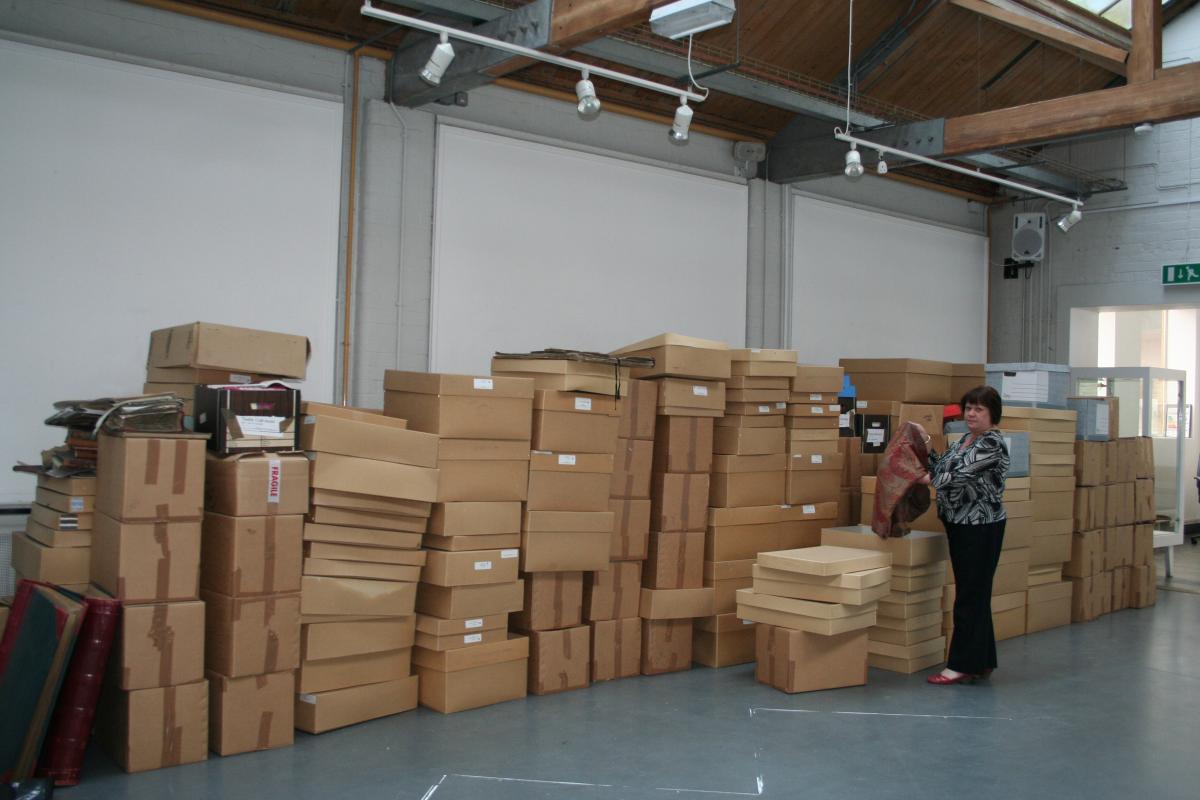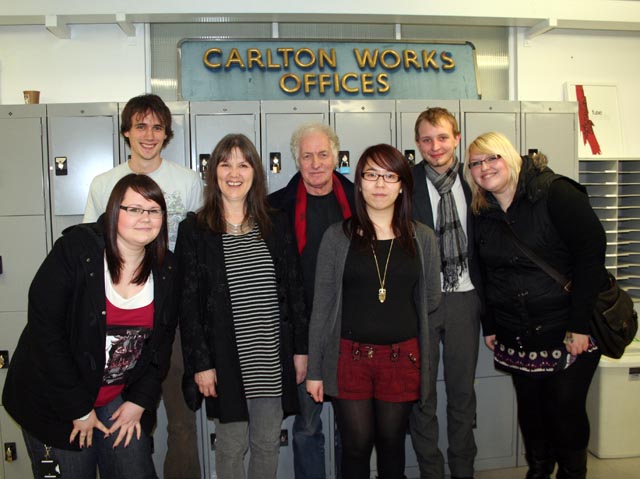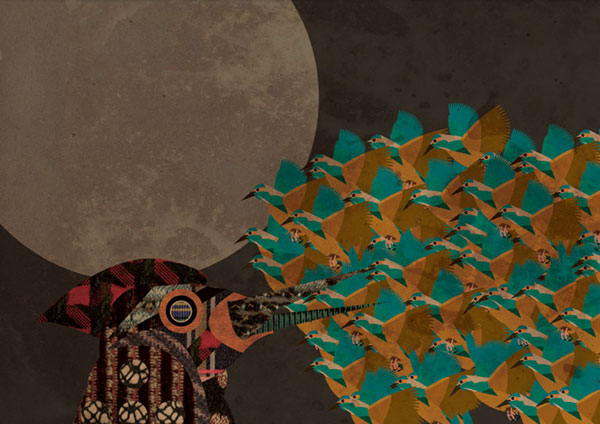Our initial steps to digitisation led to collaborative partnership work with leading institutions and produced fabulous new student art and media as part of a JISC funded case study based on engagement with the Archive. Bradford College Textile Archive opened in the Yorkshire Craft Centre in March 2000 but closed a number of  years later with the intention of relocating it to Saltaire, in a scheme led by an external consortium of different textile organisations. However, following the unexpected demise of this scheme, the Archive was returned to the College in boxes. After this extended temporary closure, Manager Clare Lamkin began work in earnest to find a new home on campus for the collections and to provide resources to ensure its sustainability and accessibility. Our journey to digitisation began in 2009, during this period of excitement and uncertainty as we prepared to make the Archive a physical reality once more, hampered by a lack of external funding, the need to appoint an archivist and non-familiarity with the collections due to prolonged unavailability.
years later with the intention of relocating it to Saltaire, in a scheme led by an external consortium of different textile organisations. However, following the unexpected demise of this scheme, the Archive was returned to the College in boxes. After this extended temporary closure, Manager Clare Lamkin began work in earnest to find a new home on campus for the collections and to provide resources to ensure its sustainability and accessibility. Our journey to digitisation began in 2009, during this period of excitement and uncertainty as we prepared to make the Archive a physical reality once more, hampered by a lack of external funding, the need to appoint an archivist and non-familiarity with the collections due to prolonged unavailability.
Arts & Cultural Projects Officer, Shelagh Ward attended a Digital Images’ Seminar organised by the Visual Arts Data Service (VADS) at the London College of Fashion in September 2009. Her introduction to VADS Director Leigh Garrett led to his visit to College and we were subsequently invited to join the VADS-led Look-Here! project. Look Here!, a recently commenced JISC funded project, was concerned with developing a community of expertise in the creation, management and use of digitised resources for teaching, learning and research in the creative arts. The project was managed by VADS and ultimately there were 7 funded partners: Arts University College at Bournemouth, Norwich University College of the Arts, University College Falmouth, University for the Creative Arts, University of Brighton, University of the Arts London, and University of Southampton; and 2 unfunded partners, Royal School of Needlework and the Bradford College Textile Archive.
Shelagh Ward attended seminars and workshops and at partner institutions and although our partnership was unfunded, JISC agreed to pay for 'an innovative student project showing the potential of digitisation.' Whilst the long-term objectives and strategy of digitising this major collection required careful planning, given that other collections, research communities and prospective users were all online, involvement in the Look Here! project and with VADS highlighted that waiting for a ‘perfect’ scenario to commence digitisation was a lost opportunity. The challenge was to commence digitisation of our vast collections on a small scale, maximising limited resources and using outputs to make an immediate impact on awareness, funding opportunities and to support and enhance learning, teaching and research. An initial selection of nneteenth century French and Indian fabric sampleswere photographed during autumn 2000. The photographs were immediately utilised to promote the Archive and its use in learning and teaching. For example, they were featured in two brochures gaining international exposure; the first was for a major collaborative event with the British Council in India in October 2010 and the second for the Sri Lanka Design Festival, where Ronan O’Beirne, Bradford College’s Director for Learning Development & Research presented a conference seminar on learning technology for fashion students and the Bradford Textile Archive, using a selection of the images.
Shelagh's proposal to test the use of the archive as a design resource for atypical student users in College and overseas was approved by JISC in November 2010. A selection of digitised images were used for a project to work with two distinct groups who would not typically be interested in seeing the original textiles in order to investigate the potential of the archive as an invaluable source of design inspiration far beyond its  appeal to those interested in textiles and textile history. Rather than selecting from more obvious areas of the College’s programmes likely to produce predictable approval and interest in the textiles, it was decided to work with students without any inclination to visit the Archive, as this would offer a better understanding of benefits which might be offered to non-traditional subject areas. Feedback from these users at the early stages of the project would offer useful supporting evidence for funders and donors, and could also help to shape the long term development of the digitisation project. Both groups were shown a selection of bound volumes of fabric samples before viewing the digitised images. Final year BA (Hons) Graphic Design Illustration & Digital Media students were given a selection of the images and set a brief to respond to them to inspire a contemporary piece of illustration, graphics or animation. The same images were also presented to a visiting group of post-graduate animation students from Whistling Woods International to assess their reactions and potential applications for animation. She arranged for College alumnus, the renowned artist Dudley Edwards and his wife Madeleine, a successful textile artist, to visit College and assess the student work in January 2011. Dudley gave an illustrated lecture which was opened up to all students within the School of Arts & Media about his fascinating career from his time with the Beatles at the heart of 1960s pop culture until the present day, before he and Madeleine critiqued the student work.
appeal to those interested in textiles and textile history. Rather than selecting from more obvious areas of the College’s programmes likely to produce predictable approval and interest in the textiles, it was decided to work with students without any inclination to visit the Archive, as this would offer a better understanding of benefits which might be offered to non-traditional subject areas. Feedback from these users at the early stages of the project would offer useful supporting evidence for funders and donors, and could also help to shape the long term development of the digitisation project. Both groups were shown a selection of bound volumes of fabric samples before viewing the digitised images. Final year BA (Hons) Graphic Design Illustration & Digital Media students were given a selection of the images and set a brief to respond to them to inspire a contemporary piece of illustration, graphics or animation. The same images were also presented to a visiting group of post-graduate animation students from Whistling Woods International to assess their reactions and potential applications for animation. She arranged for College alumnus, the renowned artist Dudley Edwards and his wife Madeleine, a successful textile artist, to visit College and assess the student work in January 2011. Dudley gave an illustrated lecture which was opened up to all students within the School of Arts & Media about his fascinating career from his time with the Beatles at the heart of 1960s pop culture until the present day, before he and Madeleine critiqued the student work.
It appeared that viewing the images digitally liberated the graphic design group from their negative preconceptions of’ textiles’ and ‘archive’ and their enthusiasm grew from actually working with the images. Students produced a fascinating range of very individual responses to the digital material. Some of this work not only utilised but expressed their vision of the Archive. Tom Hinchliffe became totally immersed in the material and devoted three weeks to developing a 1960’s inspired animated fantasy and composed his own accompanying music. Dudley said he loved the variation and pace of the animation, not just its imagination and imagery but the use of textures. Madeleine said this had taken what were “dry pages in a book and given them new life.”
 Matt Lamont produced a series of beautiful bird pictures using his own his beautiful bird illustrations overlaid with layers of the digitised samples. Lucy Wileman combined the digital images with letter press, embossing and lots of handmade elements to produce delicate digital collages. Lauren Ford built a series of striking images using drawings. Dudley and Madeleine encouraged her to extend her work by making her designs up in 3D, using the digital textile printer, remnants or by cutting up charity shop garments. Poeyen Chan produced work by drawing over the images with the pen tool and filling in with black, then digitally printing on acetate before screenprinting to produce a series of screenprints. Dudley particularly admired her experiments with a rich mix of colours and repeats and Madeleine was keen to see them printed on fabric. Poeyen also used the images with some photographs they had taken of flowers and simplified before composing flower patterns and used another photograph of a leopard to mix patterns with great effect. Joey Haran's textile map was admired for being an effective expression of the international nature of the archive. Madeleine felt that there would be huge professional interest in providing access to a digitised archive, particularly among interior designers, as well as great educational value. Regarding the collection of digitised images of19th century French fabrics, she commented, “This so contemporary in appeal but then good design is timeless. Exposing students to this will really help their work and I am very excited about this being made available.&rdquo The Bradford group felt that time pressures either as students or later in their careers, would make them unlikely to ever visit the Archive in person but following the critique, they were all brimming with enthusiasm about future use of the digitised archive and certain that they would refer to it as a source of inspiration and a reference tool.
Matt Lamont produced a series of beautiful bird pictures using his own his beautiful bird illustrations overlaid with layers of the digitised samples. Lucy Wileman combined the digital images with letter press, embossing and lots of handmade elements to produce delicate digital collages. Lauren Ford built a series of striking images using drawings. Dudley and Madeleine encouraged her to extend her work by making her designs up in 3D, using the digital textile printer, remnants or by cutting up charity shop garments. Poeyen Chan produced work by drawing over the images with the pen tool and filling in with black, then digitally printing on acetate before screenprinting to produce a series of screenprints. Dudley particularly admired her experiments with a rich mix of colours and repeats and Madeleine was keen to see them printed on fabric. Poeyen also used the images with some photographs they had taken of flowers and simplified before composing flower patterns and used another photograph of a leopard to mix patterns with great effect. Joey Haran's textile map was admired for being an effective expression of the international nature of the archive. Madeleine felt that there would be huge professional interest in providing access to a digitised archive, particularly among interior designers, as well as great educational value. Regarding the collection of digitised images of19th century French fabrics, she commented, “This so contemporary in appeal but then good design is timeless. Exposing students to this will really help their work and I am very excited about this being made available.&rdquo The Bradford group felt that time pressures either as students or later in their careers, would make them unlikely to ever visit the Archive in person but following the critique, they were all brimming with enthusiasm about future use of the digitised archive and certain that they would refer to it as a source of inspiration and a reference tool.
You can see a selection of the archive inspired student art here
A parallel focus group provided an international dimension and commented on the value of these digitised resources for providing design inspiration at a distance. This group comprised recent alumni from Whistling Woods International, Asia’s major film, television, animation and media arts institute, based in Mumbai. The group had recently collaborated with Bradford College photography students to produce a stop-motion animation film being premiered at Bradford Animation Festival in November 2010 and as they were all currently employed in the Bollywood film industry following their postgraduate Diploma in Animation, they were able to provide a professional as well as a student perspective. Location meant that this group would normally only have access to the Archive with digitisation but advantage was taken of their visit to show them original sample books, which was met with limited interest, especially the Indian fabrics. However the high resolution images were received enthusiastically and provoked lively exchange about their usage. They were all surprised that once viewed outside the confines of a dusty volume many of the French patterns appeared new and exciting and agreed that the images could be viewed for general inspiration. They were keen to use Web 2.0 technology to extend the usual search options by criteria such as colour or historical period, and to become involved in developing modern themes unrelated to the original fabric selection by tagging images with their subjective impressions of how they might be applied, for instance, rainforest, beaches and urban. They also visualised a community where users might suggest a theme for which others could help to select images. They wanted to exchange ideas and expertise, have discussions within a membership and invite professional comments and input. They were also eager to produce work in response to a set of images posted regularly which would contribute to an online portfolio of work based on the Archive, which the public could view and comment on. They envisaged this as way to develop their work and profile while developing or advancing international links and relationships. From a limited professional interest in textiles, members of the group were so impressed by the quality of images that they decided that beyond researching particular countries or historical periods, materials and textiles were very important for 3D animation and that high resolution images showing stitching and pattern in close detail would be invaluable, especially to make important characters in a story appear realistic and that even the images of the Indian fabrics would be highly desirable, as nothing similar existed locally.
Clare Lamkin and Shelagh Ward attended the Look-Here! project conference at RIBA in London on 8th February 2011 where a digital presentation about the case study was shown. The case study was published as part of the final conference proceedings, and our student work was seen by prestigious conference audience and published online.